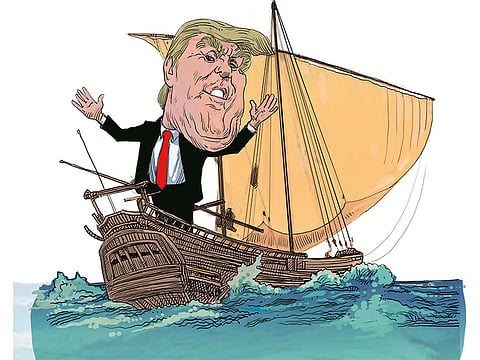UAE helps revive US interest in the region
Having found renewed US-Arab agreement on the principles, the next step will be to move to joint action

The UAE is working closely with the new administration of United States President Donald Trump, which is entirely consistent with the UAE’s strategic aim to be America’s long-term senior ally in the region. American presidents come and go, and the UAE has been able to engage to a greater or lesser degree depending on who is in the White House, but the country’s underlying aim has always been to seek a close working alliance with the world’s only real superpower.
The visit this week to Washington by His Highness Shaikh Mohammad Bin Zayed Al Nahyan, Crown Prince of Abu Dhabi and Deputy Supreme Commander of the UAE Armed Forces, was a major step in re-establishing a close working relationship with Washington after the distance experienced under the previous administration of Barack Obama. Both Shaikh Mohammad and Trump spoke warmly of their shared interests and agreed priorities, which was a welcome turnaround from the early Trump days when a stream of tweets and off-the-cuff statements seemed to indicate the incoming president was going to be a lot more confrontational in dealing with his allies in the region. Then, it was important that the UAE’s diplomatic machine in combination with its Arab allies, and its soft-power influencers, got to work to give the new Trump officials coming into office the perspective on events from the Arab Gulf side.
And the new administration found that it had a lot more in common with the committed internationalists of the Gulf than the well-publicised views of the isolationist camp in the US administration had led the world to believe. The next stage of this new engagement is to move from understanding to action, and this is what the American president may be discussing in his three summits this weekend in Riyadh with the Saudis, Gulf Cooperation Council leaders and leaders from several other Muslim nations.
For example, both Arabs and Washington want to see the restoration of established nation-states governed by the rule of law, offering stability to their citizens. They both want to see the end of Daesh (the self-proclaimed Islamic State of Iraq and the Levant) and its related terrorist groups, and the restoration of national government in countries like Iraq, Syria and Libya that are suffering terribly under the chaos of anarchy of civil war and terrorist administrations of some of their territory. This agreement has to translate into a new and more forceful strategy for the international coalition against terror in Iraq and Syria, where the fighting has been dragging on for far too long. In Syria, the agreement also has an impact on the parallel, but different process of finding an end to the civil war between the Syrian parties, for which Trump seems to have ceded the lead to Russia. However, the Gulf states will certainly want to see the US become more engaged in supporting an inclusive outcome to this terribly damaging war.
Relatively quiet
It is also a major step that Trump’s administration is not particularly tied to Obama’s nuclear deal with Iran, and US Secretary of State Rex Tillerson has started a complete review of both, the deal and Iran’s activities in the region. This suits the Arabs who have been trying to make it clear to Obama’s Washington that Iran’s active programme of destablisation across the region is very dangerous indeed and needs to be countered and stopped. Washington has been relatively quiet on this issue for fear of influencing the Iranian elections in which they would like to see President Hassan Rouhani re-elected as a more internationalist figure than his more confrontational opponents. But once the election is over, we may expect swift US action.
And Trump’s Departments of State and Defence have been far more interested in helping the Saudi Arabia-led coalition in Yemen than the Obama administration, which took a far more distanced posture on the struggle to defeat the Iranian-backed Al Houthis from the north of the country, as they sought to replace the legitimate government. Under Trump, US troops have been committed to the fight against the remnants of Al Qaida, and officials have taken steps to ease and speed up the supply of equipment to support the coalition forces — all of which is very welcome to the Arab allies in Yemen, who have been fighting a long and lonely war and winning it.
Trump will leave Riyadh for the West Bank and Israel, where he will meet both Palestinian National Authority President Mahmoud Abbas and Israeli Prime Minister Benjamin Netanyahu. Trump alarmed everyone (other than the hardline Israelis of Netanyahu’s government) when he said he did not care if the answer was a one-state or two-state solution, as long as it was agreed by both parties. This willingness to think radically about the deeply entrenched issue of the Israeli occupation of Palestine might be welcome if it breaks the impasse, but it also carries great dangers.
The logic of land-for-peace and the two-state solution has been irrefutable for decades, with the only opposition coming from Israelis, who wants to see a ‘Greater Israel’. It is hard to imagine Trump leading a breakthrough on Palestine, but the Riyadh meetings should at least caution him about the dangers of continued or expanded Israeli occupation in whatever guise.
Sign up for the Daily Briefing
Get the latest news and updates straight to your inbox



